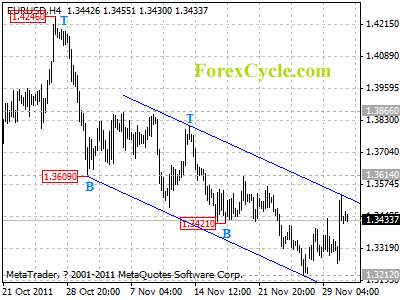By MoneyMorning.com.au
This morning your editor walked to our desk through a swarm of excited voices…
“This will squeeze a lot of shorts out of their positions.”
“When I left home the market was up 3.5%… by the time I got here it was up nearly four-and-a-half per cent.”
“The Aussie market looks like opening up 130 points.”
“Gold has taken off in U.S. dollar terms… but it’s flat in Aussie dollars.”
We can’t even tell you who said what. They were just voices. We’re not even sure there was a conversation… just people saying what they had seen.
If you haven’t seen the news headlines, you won’t know six central banks have intervened in the markets. As Bloomberg News puts it, the reason for the intervention is to make “it cheaper for banks to borrow dollars in emergencies in a global effort to ease Europe’s sovereign-debt crisis.”
The six central banks are the U.S. Federal Reserve, Bank of England, European Central Bank, Bank of Canada, Swiss National Bank, and Bank of Japan.
But aside from the obvious excitement of central bankers meddling (again) and the stock market rallying (again), what does it actually mean?
The short answer: not much.
Seen it All Before
Last week at the Daily Reckoning Doomers’ Ball we gave our prediction for the next 12 months. Our startling analysis was to predict the market would be “no higher or lower than today.”
Since then the U.S. market has gained 7.5%. Pretty good for less than a week’s work. And for all we know, the market could gain another 7.5% over the next week, month or year.
Despite that, we’re not about to change our view. We still don’t believe the market will be any higher or lower 12 months from now than it was at the start of this week.
Remember that markets move based on human behaviour (even with automated trading you’ve still got humans writing the trading programs).
And when markets move this quick, humans tend to get long-term memory loss. They look at the day’s events and think this is what markets do… they go up 4.5%… this means everything is fine.
It’s only a few days later that the regret appears… along with the recovery of their long-term memory…
Back in March this year, markets went cock-a-hoop after:
“The world’s most powerful central banks joined forces to sell billions of dollars worth of yen… The intervention by banks including the Federal Reserve, European Central Bank, Bank of Japan and Bank of England began in the early hours of Friday morning, after ministers from the Group of Seven most industrialised nations approved the first such co-ordinated action in more than a decade.” – Financial Times
So, what did the market do? It rallied 9.7% in eight weeks:
Source: Google Finance
Get onboard!
But then the market regained its long-term memory. As you can see on the following chart:
Source: Google Finance
It took another eight weeks to wipe out the gains. And by the beginning of October the short-term central bank gains were distant memories. The market had dropped 21.6% from the central bank-induced high.
Like all short-term pleasures, this excitement will wear off.
It’s times like these your editor feels like the wily old timer, sat in a rocking chair on the porch, watching the youngsters who think they’re the first to experience what’s happening.
But while we may snigger at them, we’re not about to get in the way. That’s why we sit… and watch… and wait.
[Rocking chair creaks]
Cheers.
Kris.
Related Articles
Why the Fed’s Actions Make Perfect Sense
Too Big to Bail
Swiss National Bank Intervenes…
Bailouts Still Boosting the Market
Was This Just Another Rigged Market?
From the Archives…
Stock Market Predictions
2011-11-25 – Kris Sayce
Stocks on the Australian Market Today – Three Things You Need to Know
2011-11-24 – Shae Smith
The Gospel of Gold and Silver
2011-11-23 – Kris Sayce
China’s Bubble Will Pop in 2012
2011-11-22 – Greg Canavan
ASX Stock Market Winners, Losers and the Newly Dumped
2011-11-21 – Aaron Tyrrell
For editorial enquiries and feedback, email moneymorning@moneymorning.com.au

Why Today is Blue-Chip Sell Day on the Market




